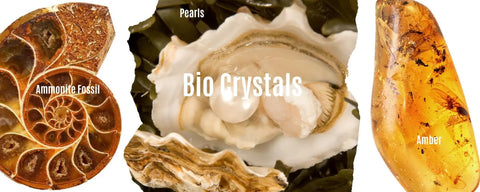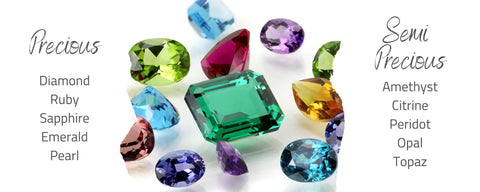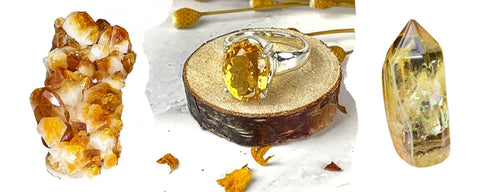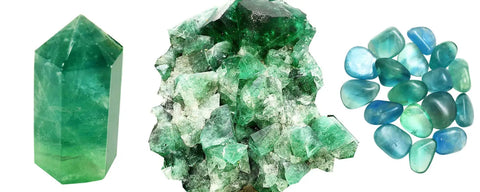What is Geology?
Geology is the scientific study of the Earth's physical structure, composition, history, and the processes that shape it. It encompasses a wide range of topics, including the study of crystals, rocks, minerals, fossils, earthquakes, volcanoes, plate tectonics, and the Earth's interior and surface processes. The basics of geology is very important for amateur and dedicated crystal collectors to better understand the terms used for minerals and how they formed. It is the forces of the Earth and its geology that contribute to their appearance, rarity and varieties.
The insights gained from the study of geology are used to understand the Earth's past, present, and future, and to address practical issues like resource exploration, environmental management, and hazard assessment. For crystal lovers, one of the most significant outcomes of geology study is insight into the age of crystals, how their growth was impacted by local geologic events and the variety of mineral environments. We are still searching for answers so the story of crystals continues to unfold with more research and awareness.
This article addresses some of the most frequently asked questions about crystals that have to do with terminology. This is a good place to start because many standard scientific terms have been morphed into common usage, what we call the vernacular or idiomatic language.
Gems, crystals, rocks, minerals and stones are terms that seem to be used interchangeably.
What are the differences?
It is true - in our everyday language the distinctions have been blurred. Today the term “crystals” has become a generic term to refer to the energy of an inorganic gem, mineral, stone or rock or the category in general. In the scientific community there are more clear-cut distinctions based on chemical and mineral composition, i.e. how the atomic structure is built and how the material was formed in the earth, the hardness of the mineral etc. However way you wish to refer to these Earth’s gifts is entirely up to you. However it is quite rewarding to learn new things about the crystal kingdom.
What is a crystal?
In common usage, the word crystal usually refers to a mineral that is being used for its specific metaphysical properties. The word itself originates from the Greek krustallos which means ice. Someone might say "I'm really into crystals" meaning that they are very interested in the category, in collecting and learning more about them generally, rather than a specific crystal or mineral.
In more scientific terms, the word crystal refers to a solid material where its atoms are arranged in an ordered, microscopic structure, i.e. the geometric spatial arrangement of atoms in the internal structure of a mineral. There are 14 basic lattice arrangements of crystals in a mineral and that design determines what a substance is. In fact, 2 different minerals can have the same crystal structure with different chemical compositions...or...the same chemical composition with different crystal structures.
What are minerals? How are minerals classified?
According to the International Mineralogical Association “A mineral is an element or chemical compound that is normally crystalline and that has been formed as a result of geological processes.” That definition basically covers everything: rocks, gemstones and even organically derived things like amber, jet and pearls. There are over 4,000 known minerals, but only about 100 of them are common. More than half of the known universe of minerals is so rare that they have been found only as handfuls or very minute specimens.
In one system of classification of minerals, there are 9 main classes that all minerals fall into based on their chemical composition. These are Silicates (quartz, garnet); Carbonates (calcites, aragonite, shell fossils); Sulfates (selenite, celestite); Halides (halite, fluorite); Oxides (hematite, ruby); Sulfides (pyrite, copper); Phosphates (Apatite, Turquoise); and Organics (jet, amber).
What is a gem? What is a gemstone?
The Gem Society defines a “gem” as "minerals that have been chosen for their beauty and durability, then cut and polished for use as human adornment." So gem refers to the ability to wear a mineral as jewelry or decoration.
What is a rock? What is a stone?
A rock is defined as a hard material of the Earth’s crust or an aggregate of one or more minerals. An aggregate example is Lapis Lazuli, which is a combination of sodium aluminum silicate with sulfur, chlorine and hydroxyl with variable inclusions of pyrite and white calcite. There are many, many rocks that are combinations of minerals that make them unique, and thus are identified by name to denote their special blend of minerals.
A stone is a solid, non-metallic mineral matter of which a rock is made. Stones can be hard or soft, while rocks are only hard. Stones are usually considered smaller than rocks.

What is a Bio Crystal or biocrystallization?
Bio crystals are derived from an organic organism like a plant or animal instead of an inorganic mineral or element. Examples of bio crystals are pearls, jet, amber, fossils such as Ammonites, or petrified wood. This can happen in a number of ways and is often referred to as biocrystallization. In some cases, minerals crystallize within the cellular structure of a plant or animal after it dies, forming the stone-like material that often resembles the living organism. In other cases, the living organism’s secretions form a unique substance we may call a “crystal.” Examples are when oysters secrete nacre to form a pearl or trees that secrete sap, harden over time into what we call amber. This process even occurs in the human body in the formation of gallstones or kidney stones.
How do crystals get their names?
Crystals derive their names from many sources:- The “ite” suffix after many crystal names is from the Greek word lithos meaning rock or stone. Ite is also a suffix often added to a word to denote an association with a person, place, tribe or system.
- Root words in Greek or Latin that are descriptive of their appearance or metaphysical properties. Amethyst means “not drunk” as people believed it prevented over indulgence. Citrine is taken from the Latin meaning citrus, referring to its yellow lemon like color.
- From the location in which they were discovered, such as Labradorite from Labrador.
- From the person’s name who first identified the crystal, such as Sugilite named after Ken-ichi Sugi, a Japanese geologist.

What is the difference between precious stones and semi-precious stones?
The difference is related to their historical value and use in jewelry but no relationship with their metaphysical value. Diamonds, Emeralds, Rubies, Pearls and Sapphires are classified as “precious” stones and are highly prized for their beauty and clarity so are most often cut with facets and highly polished to better reflect light and draw attention to their inner splendor. Before they are cut, polished or set (except for pearls) they look quite ordinary and may even look like mud. If you have ever seen an uncut diamond “in the rough” it is hard to believe that it is the same thing that is in your mother’ s engagement ring!
There are about 120 gemstones classified as semi-precious, including Citrine, Amethyst, Topaz, Opal, Aquamarine, Peridot, Lapis Lazuli etc. These can also be cut, faceted and polished for gemstone use as jewelry.
In both precious and semi-precious stones, there can be a high degree of variability in quality, color and clarity. Most often stones used in jewelry are heat treated to enhance their color as the natural color may be irregular or too light. Topaz and Emerald are good examples of gemstones found in most jewelry stores that are sold as “natural” stones as they do originate from the Earth. The "natural color" stones command a much higher price tag. However it is commonly assumed that most colored stones have been either heat treated or even lab grown. And since the metaphysical qualities of both natural and lab grown crystals are identical or nearly so, there is no qualitative difference.
What is a lab grown crystal?
Sometimes referred to synthetic or man-made, these stones are genuine in that they have the identical chemical and physical composition to those mined directly from the Earth. It is virtually impossible to tell the difference with the naked eye but synthetic crystals often have a brighter, more vivid color and are inclusion free. Although there are differences of opinion on this matter, generally quality synthetic crystals have the same metaphysical properties as “natural” crystals because their structure is identical.
Is a heat treated crystal the same as a natural crystal?
Heat treating a crystal simply mimics or enhances the natural heating process in the earth that creates crystals in the first place. At one time or another, all crystals are born from geological processes (volcanoes, earthquakes, meteorites, steam, gases, erosion, plate tectonics, compression) which generate heat. Inside the Earth are tremendous forces of heat, much of which is due to radioactive decay. Many color differences in crystals such as diamonds is due to the natural radiation in the Earth. This is why some crystals like Smoky Quartz are “irradiated” to make them appear even darker and more dramatic. This in no way changes the crystal’s core metaphysical properties. However in many cases, this type of color enhancement may actually offer additional healing value as color itself has an impact on the human psyche.

Left - Citrine rough HT specimen Center - Citrine ring faceted HT Right: Natural Citrine stone, polished, not HT
Why do some people say heat treated Citrine is fake? Is Citrine a fake crystal?
This is a hot button issue on the internet, fueled by a fundamental misunderstanding about basic geology and industry standard nomenclature. It is further complicated by the "click bait" phenomenon where people are using trending keywords for SEO reasons and ad revenue. Some simply cut and paste false information they have seen because the word "fake" scares people into looking at content that may alert them to possible scams in their world. There is absolutely no validity to the claim that heat treated Citrine is "fake." Nothing could be further from the truth, but unfortunately this is just the world we live in. Bliss Crystals has written extensive fact based articles on this issue. Here is a summary:
- Citrine is a member of the quartz family and its natural color is a yellow hue due to various concentrations of iron in the quartz. As it comes out of the Earth, Citrine’s color is quite light and it may appear pale gold, yellow or even a warm smoky brown. However this "natural" Citrine is very rare and quite expensive.
- Citrine is the commercial market name for natural quartz that is golden yellow, no matter how that color has been achieved. Virtually all Citrine on the market has been professionally heat treated to make it a deeper golden orange hue. Heat is one of the primary forming conditions of any crystal as it grows within the Earth and is a completely natural process.
- Heat treated Citrine has the exact same chemical structure as “natural” lighter Citrine. Heat naturally changes the color of many crystals so heat treated Citrine is part of this process and in no way diminishes its metaphysical properties.
-
The name Citrine is accepted without modifiers (like "fake") by the GIA, industry wide leaders, authors and professional healers. Heat treating is actually a gift in that the energy of Citrine is widely available and affordable for everyone.
- The word "fake" is only properly applied to glass or plastic products that have been fashioned to look like Citrine. These lookalikes are "fake" because they have no basis in the mineral Quartz from the Earth.

Left - polished Fluorite Generator Center - rough Fluorite cluster
Right: Fluorite polished tumbled stones
Which is better - rough or polished crystals?
The Differences
The differences are appearance, usage and personal preference. Neither form has more or less metaphysical value unless it is in the eye of the beholder. Cut or polished stones are birthed as rough or raw stones. So matter how the stone is processed, the metaphysical energy value is the same. The dollar value of cut and polished stones is higher due to the labor cost, but the metaphysical value remains the same.
Raw or Rough
Raw or sometimes called “rough” stones are left in their more natural state and sometimes more fragile, depending on the size and type. They may be in rough clusters, geodes, small stones, points, rosettes or small bits. The edges may be sharp, uneven and loose. Rough stones should be handled with care as to not break off points or crack.
Many types of crystals are best left in their rough state to enjoy their special formations. It is important to note that virtually all crystals are cleaned and sometimes repaired before sale to a customer as most are caked in hardened mud and rock when extracted from the ground. There are a few cases where rough stones could emit a dust which may be toxic to ingest. Examples are rough Malachite or Wulfenite. It is very important to wash one’s hands after handling such types of minerals and keep them away from children. However as rough specimens they are safe to display and one should enjoy their beauty and energy without excessive handling.
Polished
Polished stones are best to use when they are in contact with the body or carried in a pocket or purse. The cutting and polishing process make them smooth and easy to handle and less likely to chip or break. Polishing also prevents cuts or irritation to the skin and makes them more comfortable to use. And in the case of Malachite or crystals that may contain lead or other toxic elements, polishing them makes them safe to use.
Are raw, rough and natural crystals the same thing?
Raw and rough mean the same thing – a crystal that has not been cut or polished. A natural crystal means it is not a man made substance. A natural crystal can be raw or further processed by cutting, polishing, repairing, shaping or heat treating.
What is a man-made crystal?
These are stones called crystals which are fundamentally a synthetic creation or partially made of natural crystal. Goldstone (which is neither gold or a stone) is a glass product with real copper mineral infused. It is easily made into shapes and jewelry but it is not a natural or even synthetic crystal. It is believed to have originated with medieval monk alchemists in the 12th century.
Another all glass product is Opalite, which is completely man-made. It is a type of glass combined with dolomite and metal to best replicate natural opal's volcanic origins. As with any glass, the process starts with melting raw materials down to a liquid, then allowing the mixture to cool and solidify. There are many types of glass products that are made to replicate a natural crystal and are sold as authentic crystals. It is fairly easy to spot these true fakes with their tell tale air bubbles, out of the ordinary shapes and unnatural colors. You can compare them to costume jewelry, pretty but not real.
Does the size of a crystal matter?
Crystals possess their unique metaphysical energy in any size. This is why even small chips of diamonds delight and sparkle and one senses their purity and promise of eternal love. However, personal preference, budget concerns and availability will play into a buying decision.
When buying a crystal for healing or Feng-Shui purposes both quality and size must be considered. Clearly, the crystal should be the right size to see, handle, or fulfill its purpose. If it is too large, it would be difficult to lay on the body comfortably. If it is too small, it would not work as a specimen on a tabletop or room decoration. Very small crystals can be easily lost or ignored. Often budget may determine size that is right for you. It is the case that large specimens and smaller more rare stones are more expensive.
For polished tumbled stones, we recommend a medium to large size, which will usually work well in a body layout. That would be ¾” to 2” and in a shape that feels right.
For specimens, we recommend the largest size to fit your budget and environment. In any case, purchase the highest quality crystal available, in terms of color, markings and luminosity and the crystals that most appeal to your personal taste and intuition.
What is the Matrix? (Nope! Not the movie)
Crystals are natural occurring, having grown in the Earth. Sometimes, the underlying rock or “mother-stone” that the crystal has grown out of, is part of the specimen being offered for sale commercially. It may be very difficult for the matrix to be separated from the pure crystal form. Sometimes the matrix is a beautiful addition to the crystal and should not be separated. An example is Amethyst which can grow on quartz, agate or even basalt rock. Some crystals like Tourmaline may grown along with Quartz or Cleavelandite.
The matrix may even be another crystal, rather than a simple rock formation. An example is Chrysocolla, Cuprite and Malachite which grow simultaneously together, swirled together in luscious layers. These minerals may be closely related in their atomic structures and are predictably found together in deposits like copper or manganese.
I notice that the same crystal may come in different colors and combinations – why is this?
Think of crystals like flowers with their infinite variety of shapes, colors and petals. If you remember that most crystals are combinations of various minerals, it makes sense that depending on the specific geographic location and the variety of geologic conditions that a crystal could appear very differently from country to country. Even within a country, specific mines output the same crystal with wide variations of color, form and combinations. Take Amethyst as an example. Canadian Amethyst from the arboreal forest is known as Auralite 23 as it contains multiple minerals that make a unique color and hexagonal pattern. Amethyst from Uruguay is famous for its dark, rich “grape jelly” coloring. Vera Cruz Amethyst from Mexico has a transparent lilac color in smaller unique forms like phantoms, single and double terminated points, as well as in clusters.
A general rule of thumb is that the form and size of the crystal will usually not differ too much in its metaphysical energy vibration. Quality and intention are more important. However, it is desirable to find crystals in the right formation for the use.
What are the different forms of crystals that I can buy?
A specimen is usually a larger chunk of crystal, which may or may not include a matrix. Specimens are more often used for placement on a tabletop or desk and can range from a half pound to hundreds of pounds. Specimens can be polished, shaped or raw.
A rough or raw stone is the natural form of the crystal that has not been polished. A rough stone may be cut into small pieces or perhaps cut with a flat base so it can stand upright without a stand. Rough stones can be found in smaller sizes (like tumbled stones) or larger specimens.
A tumbled stone is a smaller crystal that has gone through a polishing process, usually in an electric tumbler. Tumbled stones are inexpensive and very effective in healing work since they are the right size to lay directly on the body.
A point is a crystal that naturally grows into a crystalline point shape. Most quartz points (clear, amethyst, citrine) have 6 sides that culminate in a point, either on one end or two. A double pointed crystal is called double terminated.
A wand is a naturally shaped longer rod shape or fashioned by a crystal artist into a longer shape that can be used to direct energy, either toward or away from something. Some crystals are found in a natural wand shape, especially Quartz. Polished wands can also be used for massage as they are smooth and free of sharp edges.
A cut & polish crystal is one that has been completely shaped by hand or machine into a particular shape. This is called lapidary. The fashioned shape may follow the original crystal shape or it may be completely different. Six sided towers, obelisks, spheres, pyramids, palm stones, free forms, cabochons, cubes and wands are types of cut and polish.
What is a crystal point?
Nature grows some crystals into the typical 6 sided point naturally. This is due to the hexagonal arrangement of its molecules forming a crystal that usually comes together at the end to form a point. The angles where those six sides meet will always be exactly 120°. The flat parts of the crystal, called crystal faces, may be different sizes, producing crystals with different shapes, but the angles between those faces will still be 120°. Because the 6 sided crystal is iconic, many people think that all crystals grow in points like Quartz. However there are 6 basic crystal structures where molecules line up in other configurations such as cubes. That's an entire discussion by itself!
When multiple crystals points are found in chunks growing together out of a matrix stone, it is called a cluster. Points can be used in body layouts and grids. Clear Quartz, Citrine and Amethyst are often sold as points.
What is acid washing? Why is my calcite crystal so smooth and shiny?
It is common practice to use a solution of muriatic (Hydrochloric) acid to clean calcite crystals. This process, called “acid washing” is used with Calcites to clean the surface, preserve their natural shape and leave a smooth, lustrous, glassy surface. It improves translucency and prevents flaking or breaking of the surface, improving its appearance and marketability. Calcites are a softer stone ranking only 3 on the Mohs scale and cleave easily. Acid washing improves their durability.



